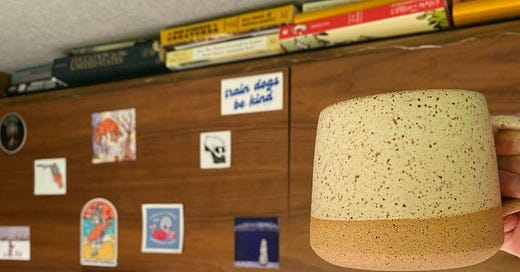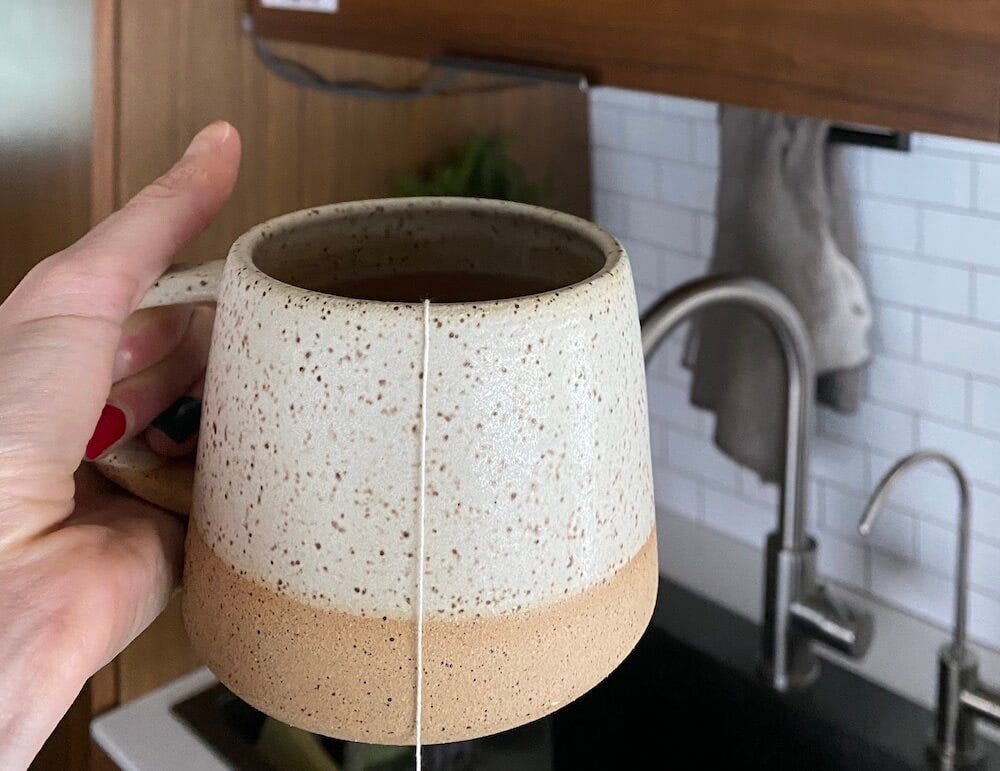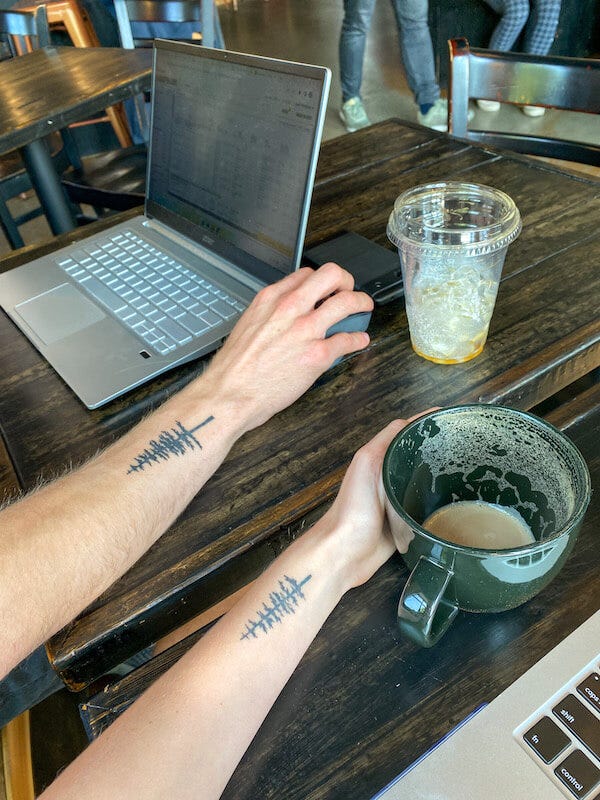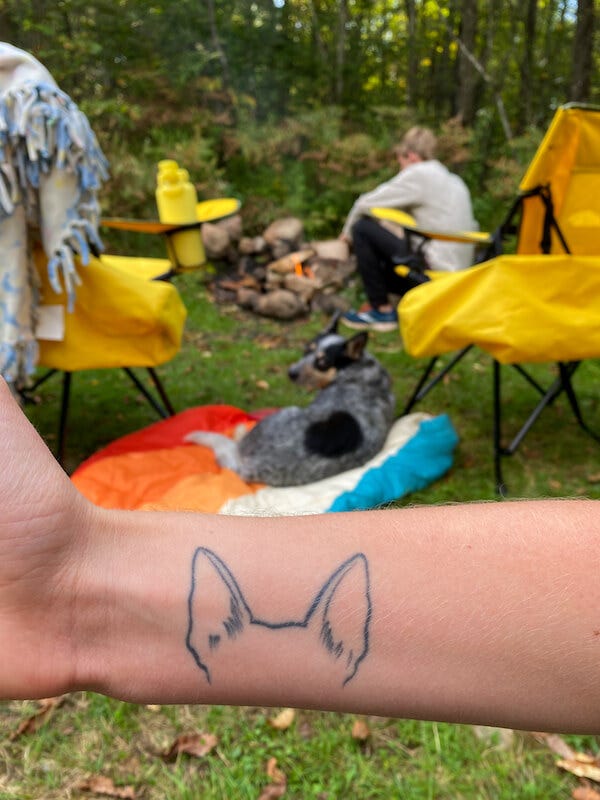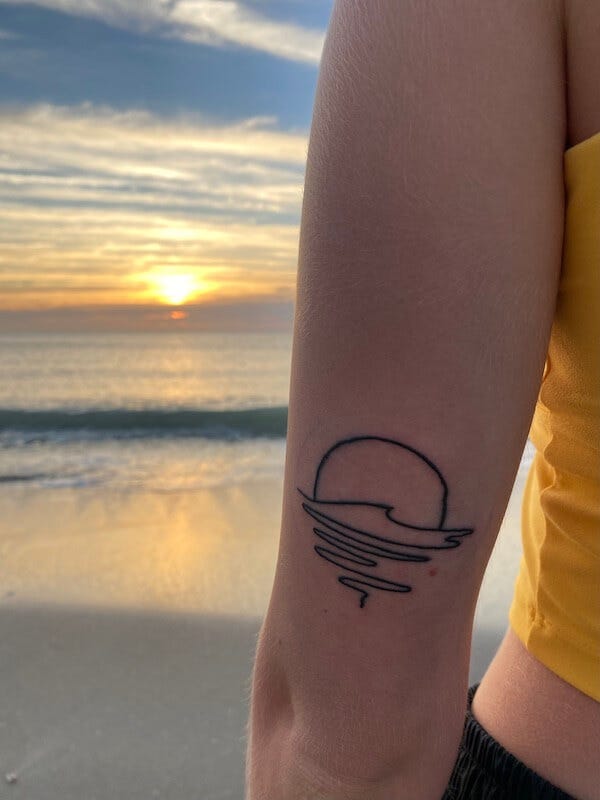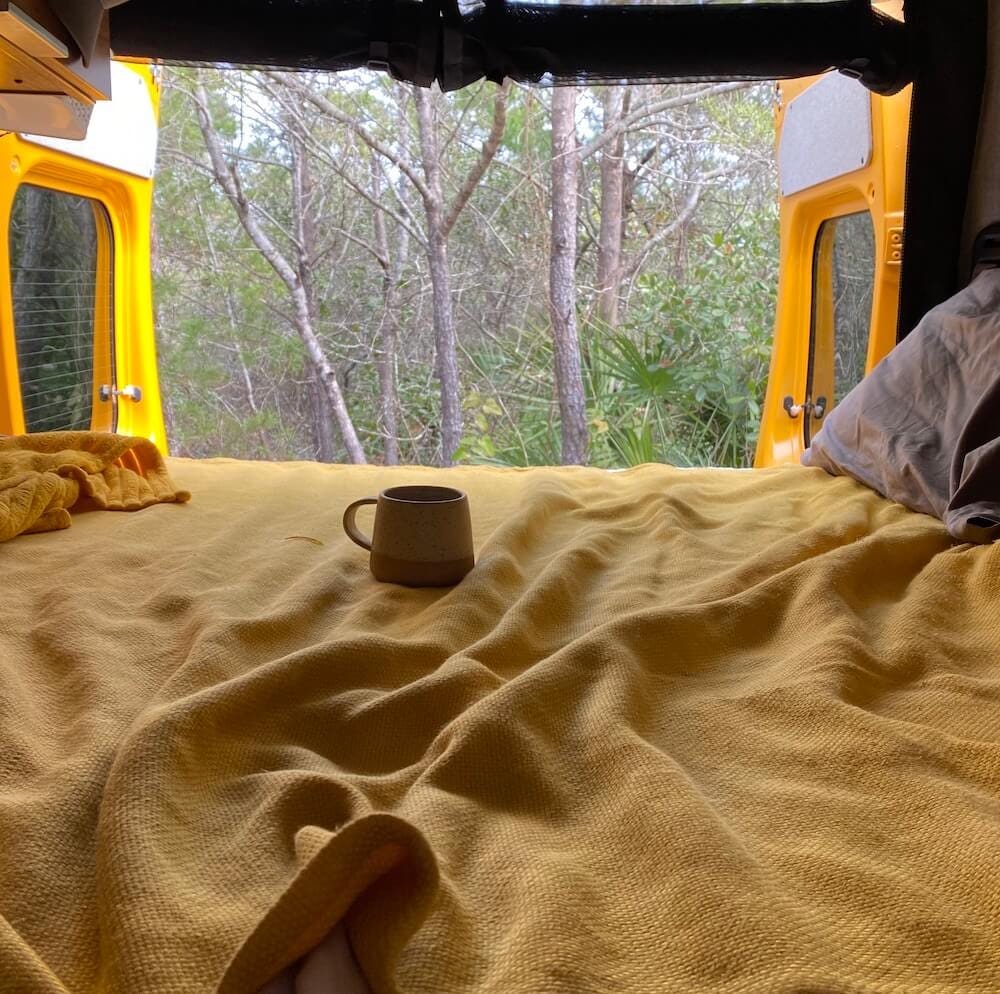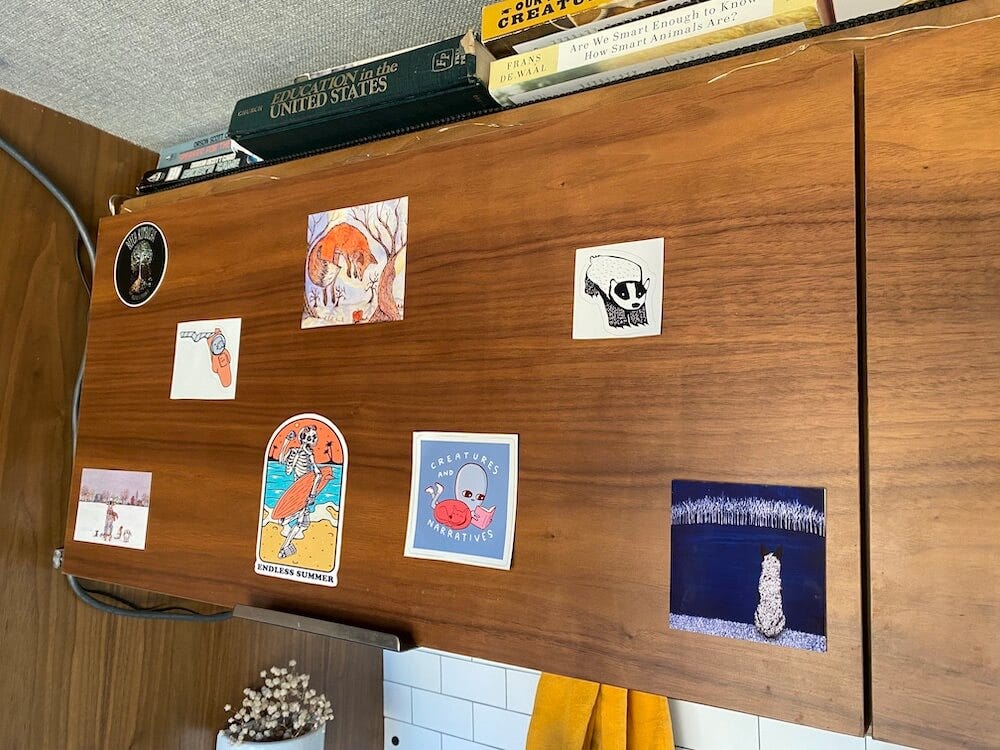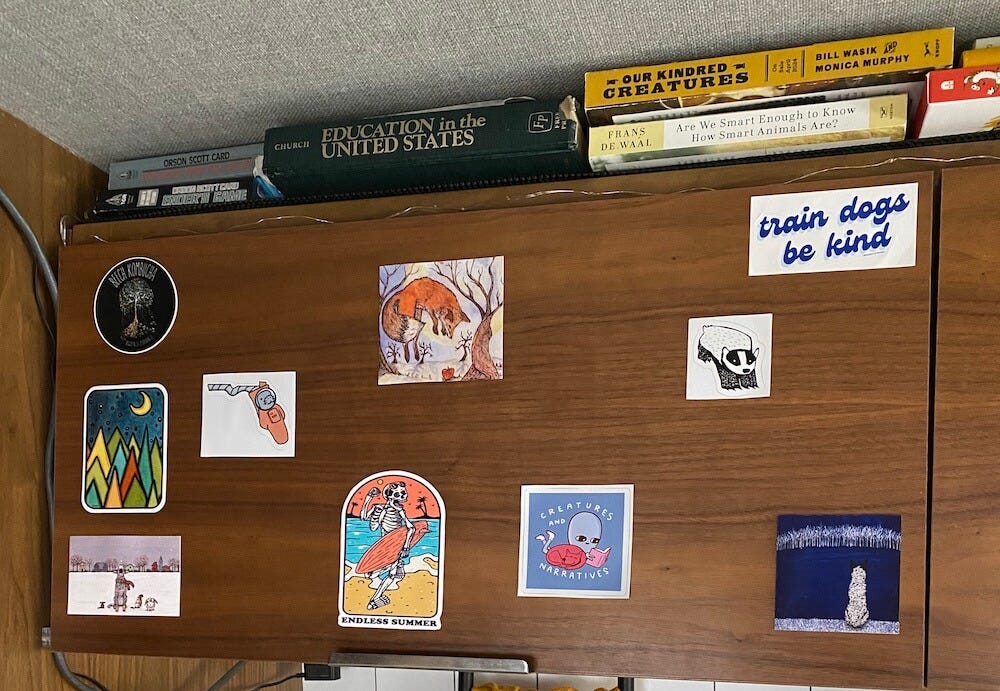This winter I bought a gorgeous mug from one of our favorite coffee shops. Love at first sight is real with handmade art — but it took me six or seven visits to finally make the purchase. Space is at a premium in our van. I was never much of an impulse shopper to start with, and any residual urge to acquire new things without thought has been stamped out in life on the road.
The barista laughed at my glee as she packaged the heavy ceramic for me that final morning. I washed my new mug as soon as we got back to the van and heated the kettle immediately.
I’ve drank from it almost every morning since.
My college finance professor was a short, loud man named Mark LaPlante. He was intimidating — students outside the major often took their finance requirement through another university to secure an “easier” teacher — but also thoughtful and fair.
One of LaPlante’s refrains was “maximize your memories per dollar”. He wanted his students to understand our country’s economic system, do well for themselves, maybe adopt a sliver of the passion he had for his field — but he didn’t want us to hoard money. He hoped we’d create meaning in our lives. Feel fulfilled. Be happy. Spend as much as you’re able to, was the underlying message, as long as it’s for something worthwhile.
I doodled the quote on a piece of stock paper and hung it on my bedroom wall, carrying it with me to my parents’ house over the summer and my next off-campus rental in the fall. Maximize your memories per dollar. I felt so wise. This was the secret!
But I didn’t follow LaPlante’s insight very well. I don’t think I understood how to make memories worth holding onto. I failed to realize it’s not about quantity — I should maximize their quality.
This spring, seven years after taking Finance 100 at the Wisconsin School of Business, I read Moonwalking with Einstein by Josh Foer. (Foer is a journalist who won the US Memory Championship in 2006.) One of the author’s friends on the “memory circuit” was a guy named Ed Cooke who said he was trying to fill his life with as many memories as possible. We anchor ourselves in time with specific recollections — X happened before the Florida vacation, after Sophie’s wedding, etc — so the more of them we have, the richer our existences seem when we look back. The longer we feel we’ve lived.
Foer noted the Peter Pan energy to this pursuit. But also, out of all the things we could collect in our modern world (blue ribbons, bank accounts, golf clubs, whatever) memories seem like a pretty great option.
Some of my best purchases obviously fit the “maximize your memories per dollar” framework. Our America the Beautiful pass costs $80 each year and grants unlimited access to the NPS’s parks and historical sites. This tiny piece of plastic enabled us to hike Delicate Arch at sunrise and Avalanche Lake at sunset and Mount Healy in Denali on the longest day of the year.
My Kindle, too, is a clear winner: about $100 for a lightweight way to read almost any book I want, thanks to my library cards and the Libby app, without physical pages crowding our van.
And don’t even get me started on my tattoos. I have seven now, all perfect in their own ways, all representing experiences (my time at an elephant sanctuary in Thailand, escaping my abusive engagement) and seasons (my childhood nickname, our Florida beach days) and love (for Scout, for Sean).
Other buys seem less “memory focused” at first pass but end up equally fulfilling. That handmade mug I finally got in Madison, Wisconsin has been the star of so many slow mornings (and a few fast ones, too) living on the road. I’ve sipped tea from it next to Scout overlooking Shenandoah’s valleys. I’ve filled it with coffee while stuck in standstill traffic, turning a travel delay into a moment of calm joy. I’ve cradled its weight in the passenger seat as the highway sprawls before us.
A hardy Cotopaxi sweatshirt I almost didn’t buy (I dragged Sean back to the store just before closing when I made up my mind) kept me warm as I hiked the Precipice Trail in Acadia National Park. I maneuvered through tears, terrified of this “non technical climbing route”, but I did it. On the summit I stretched out my arms, grinning — and that colorful fleece lights up the center of the memory. When I look at it folded above the cab of our van, I can’t help but recall how brave I’m able to be.
A paperback Calvin and Hobbes collection has been the companion to many sunny afternoons and cloudy campfire nights reading aloud with Sean, Scout curled up nearby.
I could have still sipped a warm drink on a smoky mountain morning without a specific mug. I could have trekked my way to the top of Champlain Mountain, looked over the rocky Maine coast, without a certain sweatshirt. I could laugh with Sean about hundreds of things besides a precocious six year old. These objects did not themselves make the memories — but they sharpened them. They are threads, post-it notes, tangible objects I can hold in my hand and close my eyes and feel I was there. Portkeys, almost, that fly me right back.
Because of that each is worth more than their nominal price.
A post shared by Haley (ft Scout & Sean) | Paws and Reflect (@paws.andreflect)
There is another even simpler principle at play in my current collection of belongings. It’s not always about attaching some Grand Memory to the things we buy. Sometimes it’s just that these items, independent of what goes on with and around them, bring us joy — a kind of quiet, consistent undercurrent of satisfaction.
I think associative memory is the “Marie Kondo” idea’s foundation. I read Spark Joy, a companion guide to Kondo’s original 2010 book (I admit I haven’t read the first or watched much of the Netflix show) this past January. A few of her claims struck me as outlandish — I don’t consider myself spiritual or ascribe such energy to inanimate objects — but I was captivated by her basic theory of organization.
It starts with getting rid of things we don’t love. And shamelessly holding onto those we do.
One of my favorite parts of our van is the above-sink cabinet. It’s probably the ugliest compartment in Hermes (I suppose the water and electrical cabinets under our bed are the only competition). Here you’ll find our internet modem, a bunch of cords (one snakes through the roof via a rough hole Sean proudly drilled himself, one wraps around the cabinet onto the ceiling for our router), a bin with even more cables and backup electrical supplies (laptop charging bricks, extra batteries, etc) and next to it all, claiming the bulk of the space, the tiniest 700 watt microwave you’ve ever seen.
It wouldn’t exactly be glamorous to lift that cabinet door.
Except that on the front of it we’ve taped several stickers and pieces of art. They’re some of the first things you see when you enter our house. One of them is the label from a bottle of dry cider I loved — I painstakingly warmed the wrapping with a hairdryer so I could peel it whole from the glass and attach it to a stronger piece of paper. One of them is a sticker from a kombucha brewery we visited twice within a week on the gulf coast of Florida. Three of them are silly doodles by Nathan Pyle, the author of the Strange Planet comics and one of my favorite sources of wholesome joy on the internet. Two are illustrations from Artwork by AK, a fellow cattle dog lover. The rest we’ve just picked up along the way.
These bursts of personality provide outsized returns when I look at them. None were particularly expensive. Most don’t tie to incredibly strong episodic memories. But every time I look at that cabinet — at the way we turned a dull, necessary storage compartment into a sight I love — I feel like me. semantic recollections are just as valuable as specific “what” and “where” and “when”.
Living simply in our van doesn’t mean never buying things or avoiding all impulse purchases. It means spending money in ways we find meaningful. And it means spending our time like that, too.
If I want to maximize my memories per dollar, I can’t think only about change already in my wallet. I should consider earnings potential, sure — but above all I have to realize my waking hours are most precious of all.
Fulfillment doesn’t always happen on the go go go. Some of my favorite memories are of languid days reminiscing on the grass as a family, napping in the van with the back bed doors open, floating atop ocean waves while Sean watches from the shore. Others are of sometimes difficult (sometimes tedious) work that nonetheless means something: calling representatives on human rights issues, talking through tears about problems plaguing our fellow creatures, philosophizing with Sean.
Whether agents of episodic mental travel or looser associative joy, my best investments enable me to use my time well.
Some of the best things we’ve bought lately
Hermes himself!!
America the Beautiful National Parks passes
Kindle Paperwhites
Colorblock Rumpl blanket (this was a gift, so you could argue it wasn’t actually a “purchase”… but the sentiment stands)
Matching conifer tattoos to memorialize a poem Sean wrote me years ago
Pastries from two different teahouse hikes in Banff National Park
Blue heeler shirt from Colectivo Coffee, based in Wisconsin
Colorblock Cotopaxi fleece
Rooftop mojitos in New York City
Ceramic mug from East Fork (a gift from my aunt, same sentiment as our Rumpl)
Handmade mug from Void & Form, via Johnson Public House
Inflatable canoe
Scout’s Chuckit! Air ball that we have nicknamed Squish
Yellow gooseneck kettle
A non-resident library card for a larger selection of books
Various stickers and cards we’ve put on our microwave cabinet
Brightly colored bucket hat
Time playing with dolphins in the Florida Keys
Morning coffee (and patio seating) galore at Cafe Surfinista and River Road on Florida’s space coast
First two volumes of the Calvin and Hobbes portable compendium


